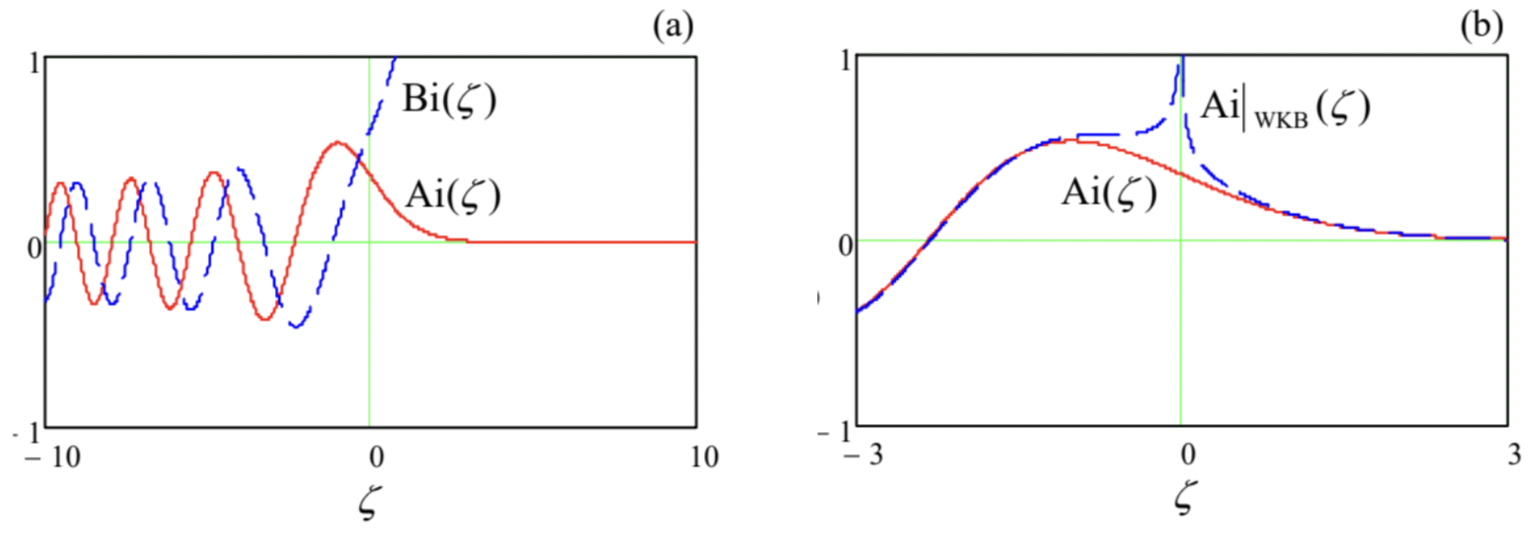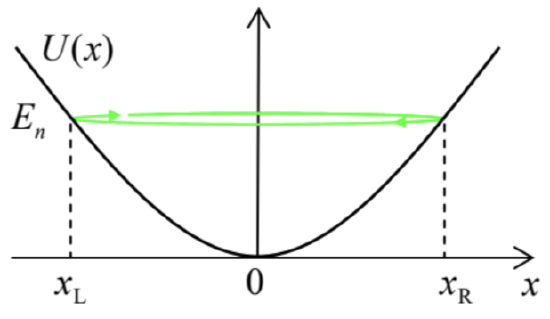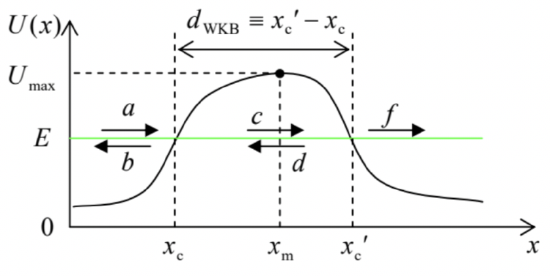2.5: Motion in Soft Potentials
( \newcommand{\kernel}{\mathrm{null}\,}\)
Before moving on to exploring other quantum-mechanical effects, let us see how the results discussed in the previous section are modified in the opposite limit of the so-called soft (also called "smooth") potential profiles, like the one sketched in Fig. 3.19 The most efficient analytical tool to study this limit is the so-called WKB (or "JWKB", or "quasiclassical") approximation developed by H. Jeffrey, G. Wentzel, A. Kramers, and L. Brillouin in 1925-27. In order to derive its 1D version, let us rewrite the Schrödinger equation (53) in a simpler form d2ψdx2+k2(x)ψ=0, where the local wave number k(x) is defined similarly to Eq. (65), k2(x)≡2m[E−U(x)]ℏ2 besides that now it may be a function of x. We already know that for k(x)= const, the fundamental solutions of this equation are Aexp{+ikx} and Bexp{−ikx}, which may be represented in a single form ψ(x)=eiΦ(x), where Φ(x) is a complex function, in these two simplest cases being equal, respectively, to (kx−ilnA) and (−kx−ilnB). This is why we may try use Eq. (83) to look for solution of Eq. (81) even in the general case, k(x)≠ const. Differentiating Eq. (83) twice, we get dψdx=idΦdxeiΦ,d2ψdx2=[id2Φdx2−(dΦdx)2]eiΦ. Plugging the last expression into Eq. (81) and requiring the factor before exp{iΦ(x)} to vanish, we get id2Φdx2−(dΦdx)2+k2(x)=0. This is still an exact, general equation. At the first sight, it looks harder to solve than the initial equation (81), because Eq. (85) is nonlinear. However, it is ready for simplification in the limit when the potential profile is very soft, dU/dx→0. Indeed, for a uniform potential, d2Φ/dx2=0. Hence, in the socalled 0th approximation, Φ(x)→Φ0(x), we may try to keep that result, so that Eq. (85) is reduced to (dΦ0dx)2=k2(x), i.e. dΦ0dx=±k(x),Φ0(x)=±i∫xk(x′)dx′, so that its general solution is a linear superposition of two functions (83), with Φ replaced with Φ0 : ψ0(x)=Aexp{+i∫xk(x′)dx′}+Bexp{−i∫xk(x′)dx′} where the choice of the lower limits of integration affects only the constants A and B. The physical sense of this result is simple: it is a sum of the forward- and back-propagating de Broglie waves, with the coordinate-dependent local wave number k(x) that self-adjusts to the potential profile.
Let me emphasize the non-trivial nature of this approximation. 20 First, any attempt to address the problem with the standard perturbation approach (say, ψ=ψ0+ψ1+…, with ψn proportional to the nth power of some small parameter) would fail for most potentials, because as Eq. (86) shows, even a slight but persisting deviation of U(x) from a constant leads to a gradual accumulation of the phase Φ0, impossible to describe by any small perturbation of ψ. Second, the dropping of the term d2Φ/dx2 in Eq. (85) is not too easy to justify. Indeed, since we are committed to the "soft potential limit" dU/dx→0, we should be ready to assume the characteristic length a of the spatial variation of Φ to be large, and neglect the terms that are the smallest ones in the limit a→∞. However, both first terms in Eq. (85) are apparently of the same order in a, namely O(a−2); why have we neglected just one of them?
The price we have paid for such a "sloppy" treatment is substantial: Eq. (87) does not satisfy the fundamental property of the Schrödinger equation solutions, the probability current’s conservation. Indeed, since Eq. (81) describes a fixed-energy (stationary) spatial part of the general Schrödinger equation, its probability density w=ΨΨ∗=ψψ∗, and should not depend on time. Hence, according to Eq. (6), we should have I(x)= const. However, this is not true for any component of Eq. (87); for example for the first, forward-propagating component on its right-hand side, Eq. (5) yields I0(x)=ℏm|A|2k(x), evidently not a constant if k(x)≠ const. The brilliance of the WKB theory is that the problem may be fixed without a full revision of the 0th approximation, just by amending it. Indeed, let us explore the next, 1st approximation: Φ(x)→ΦWKB(x)≡Φ0(x)+Φ1(x), where Φ0 still obeys Eq. (86), while Φ1 describes a 0th approximation’s correction that is small in the following sense: 21 |dΦ1dx|<<|dΦ0dx|=k(x) Plugging Eq. (89) into Eq. (85), with the account of the definition (86), we get i(d2Φ0dx2+d2Φ0dx2)−dΦ1dx(2dΦ0dx+dΦ1dx)=0. Using the condition (90), we may neglect d2Φ1/dx2 in comparison with d2Φ0/dx2 inside the first parentheses, and dΦ1/dx in comparison with 2dΦ0/dx inside the second parentheses. As a result, we get the following (still approximate!) result:dΦ1dx=i2d2Φ0dx2/dΦ0dx=i2ddx(lndΦ0dx)=i2ddx[lnk(x)]=iddx[lnk1/2(x)],iΦ|WKB≡iΦ0+iΦ1=±i∫xk(x′)dx′+ln1k1/2(x),ψWKB(x)=ak1/2(x)exp{i∫xk(x′)dx′}+bk1/2(x)exp{−i∫k(x′)dx′}. for k2(x)>0. (Again, the lower integration limit is arbitrary, because its choice may be incorporated into the complex constants a and b.) This modified approximation overcomes the problem of current continuity; for example, for the forward-propagating wave, Eq. (5) gives IWKB(x)=ℏm|a|2= const Physically, the factor k1/2 in the denominator of the WKB wavefunction’s pre-exponent is easy to understand. The smaller the local group velocity (32) of the wave packet, vgr(x)=ℏk(x)/m, the "easier" (more probable) it should be to find the particle within a certain interval dx. This is exactly the result that the WKB approximation gives: w(x)=ψψ∗∝1/k(x)∝1/vgr. Another value of the 1st approximation is a clarification of the WKB theory’s validity condition: it is given by Eq. (90). Plugging into this relation the first form of Eq. (92), and estimating |d2Φ0/dx2| as |dΦ0/dx|/a, where a is the spatial scale of a substantial change of |dΦ0/dx|=k(x), we may write the condition as ka>>1. In plain English, this means that the region where U(x), and hence k(x), change substantially should contain many de Broglie wavelengths λ=2π/k.
So far I have implied that k2(x)∝E−U(x) is positive, i.e. particle moves in the classically accessible region. Now let us extend the WKB approximation to situations where the difference E− U(x) may change sign, for example to the reflection problem sketched in Fig. 3. Just as we did for the sharp potential step, we first need to find the appropriate solution in the classically forbidden region, in this case for x>xc. For that, there is again no need to redo our calculations, because they are still valid if we, just as in the sharp-step problem, take k(x)=iκ(x), where κ2(x)≡2m[U(x)−E]ℏ2>0, for x>xc, and keep just one of two possible solutions (with κ>0 ), in analogy with Eq. (58). The result is ψWKB(x)=cκ1/2(x)exp{−∫xκ(x′)dx′}, for k2<0, i.e. κ2>0, with the lower limit at some point with κ2>0 as well. This is a really wonderful formula! It describes the quantum-mechanical penetration of the particle into the classically forbidden region and provides a natural generalization of Eq. (58) - leaving intact our estimates of the depth δ∼1/κ of such penetration. Now we have to do what we have done for the sharp-step problem in Sec. 2: use the boundary conditions at classical turning point x=xc to relate the constants a,b, and c. However, now this operation is a tad more complex, because both WKB functions (94) and (98) diverge, albeit weakly, at the point, because here both k(x) and κ(x) tend to zero. This connection problem may be solved in the following way. 22
Let us use our commitment of the potential’s "softness", assuming that it allows us to keep just two leading terms in the Taylor expansion of the function U(x) at the point xc : U(x)≈U(xc)+dUdx|x=xc(x−xc)≡E+dUdx|x=xc(x−xc). Using this truncated expansion, and introducing the following dimensionless variable for the coordinate’s deviation from the classical turning point, ζ≡x−xcx0, with x0≡[ℏ22m(dU/dx)x=xc]1/3, we reduce the Schrödinger equation (81) to the so-called Airy equation
Airy equationd2ψdζ2−ζψ=0.
This simple linear, ordinary, homogenous differential equation of the second order has been very well studied. Its general solution may be represented as a linear combination of two fundamental solutions, the Airy functions Ai(ζ) and Bi(ζ), shown in Fig. 9a.23

The latter function diverges at ζ→+∞, and thus is not suitable for our current problem (Fig. 3), while the former function has the following asymptotic behaviors at |ζ|>>1 : Ai(ζ)→1π1/2|ζ|1/4×{12exp{−23ζ3/2}, for ζ→+∞sin{23(−ζ)3/2+π4}, for ζ→−∞ Now let us apply the WKB approximation to the Airy equation (101). Taking the classical turning point (ζ=0) for the lower limit, for ζ>0 we get κ2(ζ)=ζ,κ(ζ)=ζ1/2,∫ζ0κ(ζ′)dζ′=23ζ3/2, i.e. exactly the exponent in the top line of Eq. (102). Making a similar calculation for ζ<0, with the natural assumption |b|=|a| (full reflection from the potential step), we arrive at the following result: AiWKB(ζ)=1|ζ|1/4×{c′exp{−23ζ3/2}, for ζ>0,a′sin{23(−ζ)3/2+φ}, for ζ<0. This approximation differs from the exact solution at small values of ζ, i.e. close to the classical turning point − see Fig. 9 b. However, at |ζ|>>1, Eqs. (104) describe the Airy function exactly, provided that φ=π4,c′=a′2. These connection formulas may be used to rewrite Eq. (104) as AiwKB(ζ)=a′2|ζ|1/4×{exp{−23ζ3/2},1i[exp{+i23ζ3/2+iπ4}−exp{−i23ζ3/2−iπ4}], for ζ<0, and hence may be described by the following two simple mnemonic rules:
(i) If the classical turning point is taken for the lower limit in the WKB integrals in the classically allowed and the classically forbidden regions, then the moduli of the quasi-amplitudes of the exponents are equal.
(ii) Reflecting from a "soft" potential step, the wavefunction acquires an additional phase shift Δφ=π/2, if compared with its reflection from a "hard", infinitely high potential wall located at point xc (for which, according to Eq. (63) with κ=0, we have B=−A ).
In order for the connection formulas (105)-(106) to be valid, deviations from the linear approximation (99) of the potential profile should be relatively small within the region where the WKB approximation differs from the exact Airy function: |ζ|∼1, i.e. |x−xc|∼x0. These deviations may be estimated using the next term of the Taylor expansion, dropped in Eq. (99): (d2U/d2x)(x−xc)2/2. As a result, the condition of validity of the connection formulas (i.e. of the "softness" of the reflecting potential profile) may be expressed as |d2U/d2x|<<|dU/dx| at x≈xc− meaning the ∼x0− wide vicinity of the point xc ). With the account of Eq. (100) for x0, this condition becomes |d2Udx2|3x≈xc<<2mℏ2(dUdx)4x≈xc As an example of a very useful application of the WKB approximation, let us use the connection formulas to calculate the energy spectrum of a 1D particle in a soft 1D potential well (Fig. 10).

As was discussed in Sec. 1.7, we may consider the standing wave describing an eigenfunction ψn (corresponding to an eigenenergy En ) as a sum of two traveling de Broglie waves going back and forth between the walls, being sequentially reflected from each of them. Let us apply the WKB approximation to such traveling waves. First, according to Eq. (94), propagating from the left classical turning point xL to the right such point xR, it acquires the phase change Δφ→=∫xRxLk(x)dx. At the reflection from the soft wall at xR, according to the mnemonic rule (ii), the wave acquires an additional shift π/2. Now, traveling back from xR to xL, the wave gets a shift similar to one given by Eq. (108): Δφ←=Δφ→. Finally, at the reflection from xL it gets one more π/2-shift. Summing up all these contributions at the wave’s roundtrip, we may write the self-consistency condition (that the wavefunction "catches its own tail with its teeth") in the form Δφtotal ≡Δφ→+π2+Δφ←+π2≡2∫xRxLk(x)dx+π=2πn, with n=1,2,… Rewriting this result in terms of the particle’s momentum p(x)=ℏk(x), we arrive at the so-called WilsonSommerfeld (or "Bohr-Sommerfeld") quantization rule ∮Cp(x)dx=2πℏ(n−12), where the closed path C means the full period of classical motion. 24
Let us see what does this quantization rule give for the very important particular case of a quadratic potential profile of a harmonic oscillator of frequency ω0. In this case, U(x)=m2ω20x2, and the classical turning points (where U(x)=E ) are the roots of a simple equation m2ω20x2c=En, so that xR=1ω0(2Enm)1/2>0,xL=−xR<0. Due to the potential’s symmetry, the integration required by Eq. (110) is also simple: ∫xRxLp(x)dx=∫xRxL{2m[En−U(x)]}1/2dx≡(2mEn)1/22∫xR0(1−x2x2R)1/2dx≡(2mEn)1/22xR∫10(1−ξ2)1/2dξ=(2mEn)1/22xRπ4≡πEnω0 so that Eq. (110) yields En=ℏω0(n′+12), with n′≡n−1=0,1,2,…. To estimate the validity of this result, we have to check the condition (96) at all points of the classically allowed region, and Eq. (107) at the turning points. The checkup shows that both conditions are valid only for n≫>1. However, we will see in Sec. 9 below that Eq. (114) is actually exactly correct for all energy levels - thanks to special properties of the potential profile (111).
Now let us use the mnemonic rule (i) to examine particle’s penetration into the classically forbidden region of an abrupt potential step of a height U0>E. For this case, the rule, i.e. the second of Eqs. (105), yields the following relation of the quasi-amplitudes in Eqs. (94) and (98): |c|=|a|/2. If we now naively applied this relation to the sharp step sketched in Fig. 4, forgetting that it does not satisfy Eq. (107), we would get the following relation of the full amplitudes, defined by Eqs. (55) and (58): |Cκ|=12|Ak|. (WRONG!) This result differs from the correct Eq. (63), and hence we may expect that the WKB approximation’s prediction for more complex potentials, most importantly for tunneling through a soft potential barrier (Fig. 11) should be also different from the exact result (71) for the rectangular barrier shown in Fig. 6 .
 Fig. 2.11. Tunneling through a soft 1D potential barrier.
Fig. 2.11. Tunneling through a soft 1D potential barrier.In order to analyze tunneling through such a soft barrier, we need (just as in the case of a rectangular barrier) to take unto consideration five partial waves, but now they should be taken in the WKB form: ψWKB={ak1/2(x)exp{cκ1/2(x)exp{−∫xk(x′)dx′}+bk1/2(x)exp{−i∫xk(x′)dx′}, for x<xc,fk1/2(x)exp{di∫k(x′)dx′}, for xc<x<x′c, for x′c<x, where the lower limits of integrals are arbitrary (each within the corresponding range of x ). Since on the right of the left classical point, we have two exponents rather than one, and on the right of the second point, one traveling waves rather than two, the connection formulas (105) have to be generalized, using asymptotic formulas not only for Ai(ζ), but also for the second Airy function, Bi(ζ). The analysis, absolutely similar to that carried out above (though naturally a bit bulkier), 25 gives a remarkably simple result: TWKB≡|fa|2=exp{−2∫x′cxcκ(x)dx}≡exp{−2ℏ∫x′cxc(2m[U(x)−E])1/2dx} with the pre-exponential factor equal to 1 - the fact which might be readily expected from the mnemonic rule (i) of the connection formulas.
This formula is broadly used in applied quantum mechanics, despite the approximate character of its pre-exponential coefficient for insufficiently soft barriers that do not satisfy Eq. (107). For example, Eq. (80) shows that for a rectangular barrier with thickness d≫>δ, the WKB approximation (117) with dWKB=d underestimates T by a factor of [4kκ/(k2+κ2)]2− equal, for example, 4 , if k=κ, i.e. if U0=2E. However, on the appropriate logarithmic scale (see Fig. 7b), such a factor, smaller than an order of magnitude, is just a small correction.
Note also that when E approaches the barrier’s top Umax (Fig. 11), the points xc and xc ’ merge, so that according to Eq. (117), TWKB →1, i.e. the particle reflection vanishes at E=Umax . So, the WKB approximation does not describe the effect of the over-barrier reflection at E>Umax. (This fact could be noticed already from Eq. (95): in the absence of the classical turning points, the WKB probability current is constant for any barrier profile.) This conclusion is incorrect even for apparently smooth barriers where one could naively expect the WKB approximation to work perfectly. Indeed, near the point x=xm where the potential reaches maximum (i.e. U(xm)=Umax ), we may always approximate any smooth function U(x) with the quadratic term of the Taylor expansion, i.e. with an inverted parabola: U(x)≈Umax−mω20(x−xm)22. Calculating derivatives dU/dx and d2U/dx2 of this function and plugging them into the condition (107), we may see that the WKB approximation is only valid if |Umax−E|≫>ℏω0. Just for the reader’s reference, an exact analysis of tunneling through the barrier (118) gives the following Kemble formula: 26 T=11+exp{−2π(E−Umax)/ℏω0}, valid for any sign of the difference (E−Umax). This formula describes a gradual approach of T to 1 , i.e. a gradual reduction of reflection, at the particle energy’s increase, with T=1/2 at E=Umax.
The last remark of this section: the WKB approximation opens a straight way toward an alternative formulation of quantum mechanics, based on the Feynman path integral. However, I will postpone its discussion until a more compact notation has been introduced in Chapter 4.
19 Quantitative conditions of the "softness" will be formulated later in this section.
20 Philosophically, this space-domain method is very close to the time-domain van der Pol method in classical mechanics, and the very similar rotating wave approximation (RWA) in quantum mechanics - see, e.g., CM Secs. 5.2−5.5, and also Secs. 6.5,7.6,9.2, and 9.4 of this course.
21 For certainty, I will use the discretion given by Eq. (82) to define k(x) as the positive root of its right-hand side.
22 An alternative way to solve the connection problem, without involving the Airy functions but using an analytical extension of WKB formulas to the complex-argument plane, may be found, e.g., in Sec. 47 of the textbook by L. Landau and E. Lifshitz, Quantum Mechanics, Non-Relativistic Theory, 3rd ed. Pergamon, 1977.
23 Note the following (exact) integral formulas,
Ai(ζ)=1π∫∞0cos(ξ33+ζξ)dξ,Bi(ζ)=1π∫∞0[exp{−ξ33+ζξ}+sin(ξ33+ζξ)]dξ,
frequently more convenient for practical calculations of the Airy functions than the differential equation (101).
24 Note that at the motion in more than one dimension, a closed classical trajectory may have no classical turning points. In this case, the constant 1/2, arising from the turns, should be dropped from Eqs. (110) written for the scalar product p(r)⋅dr - the so-called Bohr quantization rule. It was suggested by N. Bohr as early as 1913 as an interpretation of Eq. (1.8) for the circular motion of the electron around the proton, while its 1D modification (110) is due to W. Wilson (1915) and A. Sommerfeld (1916).
25 For the most important case TWKB <<1, Eq. (117) may be simply derived from Eqs. (105)-(106) - the exercise left for the reader.
26 This formula was derived (in a more general form, valid for an arbitrary soft potential barrier) by E. Kemble in 1935. In some communities, it is known as the "Hill-Wheeler formula", after D. Hill and J. Wheeler’s 1953 paper in that the Kemble formula was spelled out for the quadratic profile (118). Note that mathematically Eq. (119) is similar to the Fermi distribution in statistical physics, with an effective temperature Tef =ℏω0/2πkB . This coincidence has some curious implications for the Fermi particle tunneling statistics.


